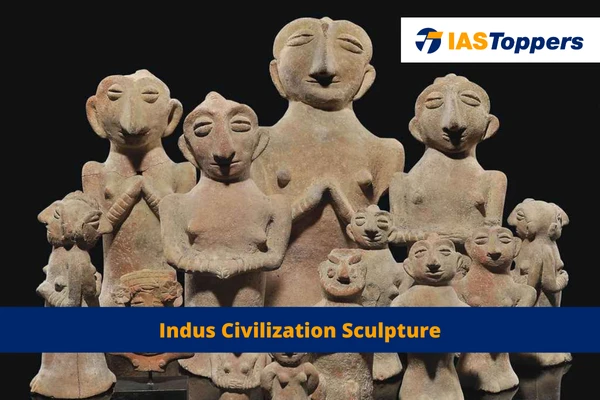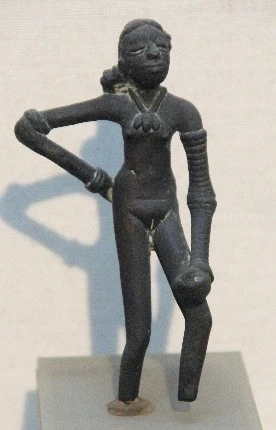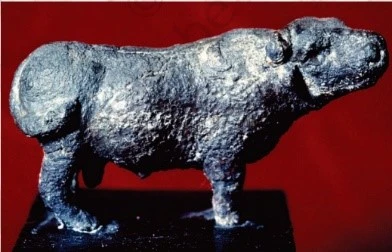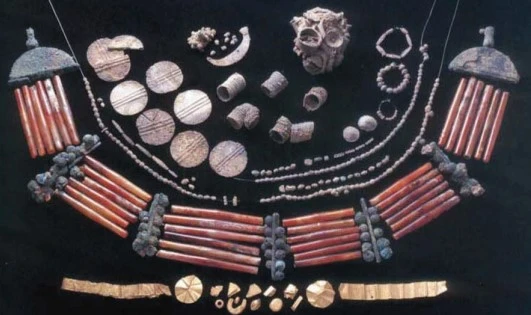The Indus Valley Civilization, known for its exceptional understanding of urban planning, has a rich tradition of sculpture and art. Such sculptures, ranging from stone statues, bronze casting, terracotta work to the seals, pottery, beads and ornaments, shows their advanced craftsmanship skills. These sculptural arts of Indus valley civilization are not only artistic relics but also powerful historical documents that hold great importance in Indian History.
In this article, you will know about art of sculpture of Indus valley civilization, including its Stone Statues, Bronze Casting, Terracotta Figures, Seals, Pottery, and Beads & Ornaments, all of which are important for GS Paper-1 Art & Culture of UPSC IAS Exam. To explore more interesting UPSC Ancient History topics like Indus valley sculptures, check out other articles and IAS Notes of IASToppers.
Table of Content
- Indus valley sculpture
- Stone Statues during Indus Valley Civilization
- Bronze Casting during Indus Valley Civilization
- Terracotta during Indus Valley Civilization
- Seals during Indus Valley Civilization
- Pottery during Indus Valley Civilization
- Beads and Ornaments
- Conclusion
- FAQs on Indus Valley Civilization Sculpture
Indus valley civilization sculpture
- The arts of the Indus Valley Civilisation emerged during 2nd half of the third millennium BCE.
- The forms of art found from various sites of the nidus valley civilisation include sculptures, seals, pottery, jewellery, terracotta figures, etc.
- Their delineation of human and animal figures was highly realistic in nature, since the body structure details included in them were unique.
- In the case of terracotta art, the modelling of animal figures was done in an extremely careful manner.
Stone Statues during Indus Valley Civilization
- Among the stone sculpture of Indus valley, there are two male figures—one is a male torso sculpture in red sandstone and the other is a bust of a bearded man in soapstone.
- Key features of bearded man:
- Bearded man is a priest.
- It is draped in a shawl (decorated with trefoil patterns) covering the left shoulder.
- Eyes are elongated, and half-closed.
- Well-formed medium size nose; with moustache and a short beard and whiskers;
- Armlet on the right hand and holes around the neck suggest a necklace.
- Key features of Male Torso

- A red sandstone figure,
- Has socket holes in the neck and shoulders for the attachment of head and arms.
- Shoulders are well baked and the abdomen slightly prominent.
Bronze Casting during Indus Valley Civilization
- The art of bronze casting was practised on a wide scale by the Harappans.
- Their bronze Indus valley sculptures were made using the ‘lost wax’ technique.
- In this, first, thewax figures were first covered with a coating of clay and allowed to dry.
- Then the wax was heated and the molten wax was drained out through a tiny hole made in the clay cover. The hollow mould thus created was filled with molten metal which took the original shape of the object. Once the metal cooled, the clay cover was completely removed.
- Copper dog and a bird was found from Lothal and a bronze figure of a bull from Kalibangan.
- Late Harappan and Chalcolithic sites like Daimabad in Maharashtra shows examples of metal cast sculptures of human and animal figures of Indus valley civilization.
- Examples of bronze figures: Dancing Girl, Buffalo with uplifted head, back and sweeping horns and the bronze goat.
Key features of Dancing Girl of Indus valley civilization
- Founded in Mohenjo-Daro.
- with her right hand on her hip and her left
- The figure is lanky, thin and rhythmic in character.
- Shown without clothes with bangles in left hand till almost her shoulder.
- Her hair is tied in a bun and has cowry shell necklace.
- She stands in a resting posture with her right hand at her waist and her left hand on her left thigh.
- Though this is 4 inches in height only, it seems to be a larger one to us, making it unique.
Key features of Bull from mohenjodaro
- It is standing with his head turned to the right
- It has cord around neck.
Terracotta during Indus Valley Civilization
- Terracotta sculpture of Indus valley civilization mainly include basic humans figurines.
- More terracotta pieces were found in Gujarat sites and Kalibangan.
- Mother goddess, a beautiful terracotta sculpture of Indus valley, were highly significant in Indus terracotta art.
- Bearded male figurines with coiled hair were also discovered.
- A terracotta mask of a horned deity has also been found.
- Toy carts with wheels, whistles, rattles, birds and animals, gamesmen and discs were also found in terracotta.
- Most of the toys were found around Mohenjo-Daro, that reflected the societal norms, living conditions, and the fauna of the area in 2000 BCE. The most common Indus valley civilisation animal toy was the bull.
Key features of mother goddess figures
- Adorned with necklaces and wearing a loin cloth and a girdle.
- Fan-shaped head-dress with a cup-like projection on each side
- Pellet eyes and beaked nose are crude, and mouth is indicated by a slit.
Seals during Indus Valley Civilization
- Numerous seals, primarily made of steatite, were found.
- Some seals are made of agate, chert, copper, faience and terracotta,
- Depicted various animals, such as unicorn bull, rhinoceros, tiger, elephant, bison, goat, buffalo, monsters etc.
- Main purpose of producing seals: Commercial.
- Seals were also used as amulets, as modern-day identity cards.
- Standard Harappan seal was a square plaque 2×2 square inches.
- Every seal is engraved in a pictographic script.
Pasupathi Seal:
- Displays a central human figure surrounded by animals.
- Features an elephant and tiger on the right, and a rhinoceros and buffalo on the left
- Originated between 2500 and 1900 BCE, found in sites like Mohenjo-Daro.
- Square or rectangular copper tablets with animal/human figures and inscriptions were also discovered, serving as amulets.
Pottery during Indus Valley Civilization
- Numerous pottery artifacts unearthed at archaeological sites
- Predominantly fine, wheel-crafted pottery, with limited hand-made pieces
- Plain pottery: Made from red clay, sometimes featuring red or grey slip, more prevalent than painted pottery.
- Black painted ware: Fine coating of red slip-on which designs are executed in glossy black paint.
- Polychrome pottery: Rare, featuring small vases adorned with geometric designs in red, black, green, occasionally white and yellow.
- Perforated pottery: Used for filtering liquids, with a large hole at the bottom and numerous small holes throughout.
- Pottery for household: It is found in as many shapes and sizes as could be conceived of for daily practical use.
- Straight and angular shapes are an exception, while graceful curves are the rule.
Beads and Ornaments
- While necklaces, fillets, armlets and finger -rings were commonly worn by both sexes, women wore girdles, earrings and anklets.
- Jewellery found at Mohenjodaro and Lothal: Necklaces of gold and semi-precious stones, copper bracelets and beads, gold earrings and head ornaments, faience pendants and buttons, and beads of steatite and gemstones.
- Cemetery has been found at Farmana in Haryana where dead bodies were buried with ornaments.
- Factories discovered at Chanhudaro and Lothal.
- Bead materials: Various stones (carnelian, amethyst, jasper, crystal, quartz, steatite, turquoise, lapis lazuli), metals (copper, bronze, gold), and other materials (shell, faience, terracotta).
- Bead shapes: Disc, cylindrical, spherical, barrel, segmented.
- Bead designs: Combinations of stones, gold-covered beads, painted decorations, etched patterns.
- Large number of spindles shows that spinning of cotton and wool was very common in the houses of the Indus Valley.
Conclusion
The Indus Valley Civilization (IVC), also known as the Harappan Civilization, was one of the world’s earliest urban cultures, thriving along the Indus River and its tributaries in what is now Pakistan and northwest India from around 3300 BCE to 1300 BCE. The art and sculpture of Indus valley civilization showcased their advanced skilled craftsmanship. From stone statues and bronze castings to terracotta figures and intricate seals, these artifacts provide valuable insight into the ancient civilization’s culture, religion, and daily life. The preservation and study of these Indus sculpture are essential to deepening our understanding of the roots of modern Indian society. Around 1900 BCE, the Indus Valley Civilization began to decline. The Indus Valley Civilization left a lasting legacy that influenced later cultures in the Indian subcontinent.
Ref: Source-1
| Other Articles in History & Culture | |
| Tripitaka | Pala Dynasty |
| Gupta Coins | Harappan architecture |
| Miniature Painting | Theravada Buddhism |
FAQs (Frequently Asked Questions)
What are some of the famous sculptures of Indus valley Civilization?
Some of the famous sculptures of Indus valley Civilization of mohenjo daro include Stone Torso, the Priest King, the Dancing Girl, the Bronze Bull, and terracotta figures such as the Mother Goddess.
What were the key features of the Dancing Girl and the Bull sculptures from the Indus Valley Civilization?
The Dancing Girl sculpture from the Indus Valley Civilization is unique for its thin, and rhythmic form, showcased in a resting posture. She is adorned with bangles and a cowry shell necklace. The Bull, on the other hand, is showed with a cord around its neck, standing with its head turned to the right.
How was pottery utilized during the Indus Valley Civilization, and what were its characteristics?
Pottery during the Indus Valley Civilization was primarily wheel-crafted, having fine red clay, sometimes with a red or grey slip. They had diverse shapes and sizes for practical daily use, with graceful curves. The pottery types included plain pottery, black painted ware, polychrome pottery, and perforated pottery.






